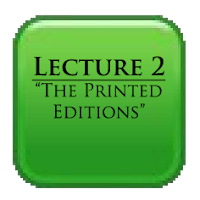A video of this presentation is available on the Maxwell Institute's YouTube page here.
This podcast is one part in a series of three lectures given by Dr. Royal Skousen as part of his 25 year magnum opus work on the textual criticism of the Book of Mormon.
About Royal Skousen
Skousen has published three books on this subject: Analogical Modeling
of Language (1989), Analogy and Structure (1992), and Analogical Modeling: An
Exemplar-Based Approach to Language (2002). More recently, he has published on
the quantum computation of Analogical Modeling, notably in his 2005 paper
"Quantum Analogical Modeling" (available here).
Skousen has been the editor of the Book of Mormon Critical Text Project
since 1988. In 2001, he published the first two volumes of the Critical Text
Project, namely, typographical facsimiles for the original and printer's
manuscripts of the Book of Mormon. From 2004 through 2009, he published the six
books that make up volume 4 of the critical text, Analysis of Textual Variants of the Book of Mormon. This work
represents the central task of the Critical Text Project, to restore by
scholarly means the original text of the Book of Mormon, to the extent
possible. In 2009, using the results from volume 4, Skousen published with Yale
University Press the culmination of his critical work on the Book of Mormon
text, namely, The Book of Mormon: The
Earliest Text. The Yale edition presents the reconstructed original text in
a clear-text format, without explanatory intervention. Unlike modern editions
of the Book of Mormon that have added chapter summaries, scriptural
cross-references, dates, and footnotes, this edition consists solely of the
words dictated by Joseph Smith in 1828-29, as far as they can be established
through standard methods of textual criticism. Later emendations by scribes,
editors, and even Joseph Smith himself have been omitted, except for those that
appear to restore original readings. Skousen is currently writing volume 3 of
the critical text, The History of the
Text of the Book of Mormon, which will be available in about three years (~2016).
Skousen has recently accepted the assignment
to be one of the editors for the Joseph Smith Papers, along with Robin Jensen,
charged with the task of preparing the three volumes that will reproduce
photographs and facsimile transcripts for the two manuscripts of the Book of
Mormon.
For those interested, Skousen's vita is available via Brigham Young University here.
For those interested, Skousen's vita is available via Brigham Young University here.
About this Lecture
 |
| The Gordon B. Hinckley Alumni and Visitors Center |
This lecture examines the nature of the original text, as recovered by scholarly means as part of the Book of Mormon Critical Text Project. It is important, first, to note the number and kinds of changes that have been implemented in The Earliest Test (Yale University Press, 2009). Of 606 readings in the Yale text, 216 come from the original manuscript (O), 187 from the printer's manuscript (P), and 88 from both O and P.
The manuscripts play the most important role in recovering the original text. Since O is only 28% extant, this means that by human means most of the original text is not fully recoverable. Nonetheless, there are 241 new reading that make a difference in meaning; these changes would show up in any translation of the Book of Mormon. Various examples are discussed that show how the original text was more consistent in usage. In addition a few changes in names make a difference in how we interpret the narrative.
Conjectural emendations are found in the Yale edition as in all editions of the Book of Mormon, but much less frequently. On average, about one out of every four proposed conjectural emedations have been accepted in the Yale Edition.
The original text itself shows word-for-word control in its Hebrew-like expressions, the large number of lexical meanings dating from the 1500's and 1600's, its use of 131 instances of fully consistent expressions, identical non-biblical citations from different parts of the test, and the spelling out of the Book of Mormon names letter by letter. Even the non-standard grammar of the Book of Mormon may date back to Early Modern English.
This information was largely retrieved from "Interpreter: a Journal of Mormon Scripture".







